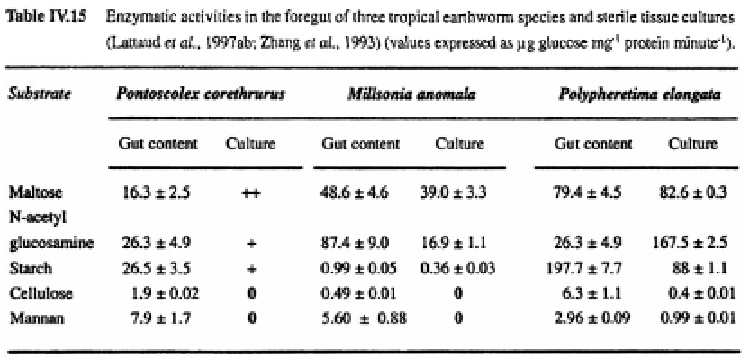Agriculture Reference
In-Depth Information
Favourable conditions for micro-organism activity occur in the anterior part of the
gut: high water contents (100 to 150 % of the dry weight of soil), neutral pH and, above
all, high concentrations of readily assimilable mucus (5-16 % depending on the species)
(Barois and Lavelle, 1986). This mucus is a mixture of low molecular weight (
ca.
200 Da)
amino-acids and oxides and a glycoprotein of 40 to 60 kDa (Martin
et al.,
1987). In the
mid-gut, micro-organisms whose metabolism has been sharply increased by feeding
on mucus, become able to digest soil organic matter. Their activity at 28 °C is then 6 to
10 times higher than in the control, and perhaps up to 30 times that in undisturbed field
conditions. The products of their external digestion are partly reabsorbed with water in
the posterior part of the gut.
Through this process, an estimated 3 to 19 % of soil organic matter may be assimi-
lated during a gut transit which may last from 30 minutes to 2-4 hours (Lavelle, 1978;
Martin, 1989; Barois, 1987). Evidence also exists for a mutualistic digestive system in
the temperate-climate earthworms
Allolobophora molleri
and
Octolasium tyrtaeum
(Trigo and Lavelle, 1993; Trigo and Lavelle, 1995).
The efficiency of this digestive system is highly dependent on temperature. When the
temperature falls from 27 °C to 15 °C, increased microbial respiration in the posterior
gut of
Pontoscolex corethrurus
is limited to twice the control value, with maximum rates
diminished respectively by 70 and 85 % at 20 and 15 °C in comparison with respiration
rates measured at 27 °C (Figure IV.46). In temperate-climate earthworms, the microflora is
more active at 20 °C than at 27 °C, although mutualistic digestion seems to be less efficient.
The lower efficiency may be compensated for by a higher-quality food resource, and
an increased production of intestinal mucus in the gut (Figure IV.47). This may explain
why earthworms tend to feed more on litter in cooler climates. Drought, by reducing
the periods of activity, is likely to have a similar effect on communities. Finally, nutrient
deficiencies, especially of nitrogen, may also constrain earthworms to use resources with
higher nutrient contents
i.e.,
the organic matter of the uppermost centimetres of the soil and
leaf litter. This is supported by the dominance of litter-feeding earthworms in tropical
forests with acid, nutrient-poor soils (Fragoso and Lavelle, 1992).
The relative contributions of the three digestive systems are thus expected to vary
with microclimate and the quality of resources available.

